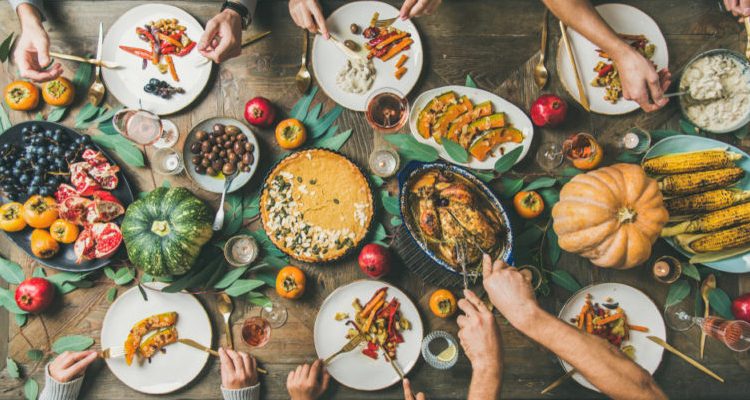Well, here we are in October, and whether we are ready or not the fall and winter feasts are rapidly approaching. This time of the year is typically a time filled with family, friends, memories, food…and lots of it! October through the New Year tends to be that time we eat more sweets, eat larger portions, or eat more food in general which, consequently, could lead to weight gain. According to WebMD, any fat gain that does occur from holiday over-eating typically occurs after the holidays because fat gain takes many days, weeks, or even months of overeating to accumulate. The initial weight gain after feast days is more likely from 1) salty foods and 2) increased storage of carbohydrates (aka glycogen), both resulting in more water absorption. Hence, why your clothes may become a little tighter around the waist, especially when this period is coupled with less activity and exercise. Now multiply the number of years this trend has continued, and the significant weight gain over the years makes more sense (WebMD “Holiday Weight Gain a Big Fat Lie”).
Unprecedented challenges have crept into everyone’s lives in one way or another these recent months. New challenges can bring new opportunities, yielding new accomplishments if you allow it. This may be the season for you to focus and achieve better health and immunity. Nutritional habits have this tremendous power—food can either be your pitfall in health or food can empower your health. Instead of indulging in self-sabotaging habits such as the ones mentioned previously, take the steps to become more intuitive, or mindful, of your eating habits.
We defined intuitive eating in part one as the ability to stay tuned in to your body’s natural hunger and fullness cues. Review our May County Connection to view the many benefits and strategies we discussed in part one.
Strategy #1: Using the hunger scale.
The Hunger Scale below is an effective, simple strategy to discover how you should and should not feel when eating intuitively. The idea is to stay within the green zone and avoid the caution and red zones when you begin and stop eating. For example, begin eating when you are mildly hungry (zone 4) and stop when you are satiated or mildly full, with no discomfort (zones 5-6). The feeling of starvation or famished (zones 1-3) and eating to the point of discomfort, or feeling sick, (zones 8-10) should be avoided. Practicing this routinely will yield a positive impact on your energy levels and lessen negative emotions, such as irritability or being “hangry”. Be sure to keep a journal as a reminder and reference tool.

Strategy #2: Nourish yourself by other means.
We tend to treat the sudden onset of hunger as an emergency by instantly ravaging the fridge or cabinet to fulfill what we think is hunger. Hunger works in waves of about 3-4 hours and then it calms. Try these options to learn how to break the habit. The intent is to identify the trigger, and then discipline your thinking about food to create a new habit.
- Self-experimentation: Exploring tactics that work or do not work for you. When you pay attention to how foods make you feel it empowers you and energizes you to make better choices
- Try to skip a meal or two. Use your journal to make notes on how it made you feel.
- Instead of acting on the hunger, wait for your next scheduled eating time.
- Try scheduling a 24-hour fast or try an intermittent fasting day (I.e., Refrain from eating for 14-16 hours, and eat the remaining 8-10 hours.)
- Indulge in your stress (psychological) eating. By doing this it will allow you to identify the trigger. Write it down as a reminder so the next time you may remember to stop.
- Replace non-scheduled or triggering eating habits with something you enjoy doing that takes less than 15 minutes, such as:
- Do a workout
- Go for a walk
- Call a friend or family member
- Deep breathing exercises
- Listen to music or a podcast
- Play with your pet or kids, etc.
Strategy #3: Plan to indulge.
Be honest with yourself—we all like to eat during the holidays, and there is no way around eating. If this describes your sentiment about food on the holidays but you typically do well with eating habits during other times of the year, then just plan to indulge. However, the keyword is “plan”. Here are some ideas:
- Significantly cut back on intake, mainly carbohydrates, about 1-2 weeks prior to the scheduled feast. This could help combat the increased carbohydrate and water storage weight.
- Go for a walk right after you eat. This will metabolize the food by using it as energy for the activity reducing the amount of energy storage.
- Increase your exercise and activity levels the weeks up to and after the holiday season.
Final Thoughts
Try not to beat yourself up. A successful journey is persistently pursuing ways to learn, whether from accomplishments or from mistakes, and continuing to move forward. Striving for perfection will only let you down, and the stress makes weight gain worse. Allowing yourself to indulge here and there is ok, but overindulging often is the issue. However, this should not be used as a permanent get-out-of-jail-free card by letting yourself off the hook. A key distinction here is that self-compassion is not an excuse to stress eat or indulge. Its purpose is to help remove some of the guilt. Enjoy your fall and winter holiday feasts and may it be filled with joy and memories, but stay healthy!
If you are interested in receiving health coaching on this topic, please contact Joshua Gaskins at [email protected].
